Dip bar exercises are a versatile and effective way to build upper body strength, targeting muscles like triceps, chest, and abs. Perfect for home or gym use, they offer a convenient, cost-effective way to improve fitness for all levels.
What Are Dip Bars?
Dip bars are a type of fitness equipment consisting of two parallel bars, either free-standing or attached to a stable object. They are designed to support bodyweight exercises.
These bars are versatile, allowing users to perform various exercises targeting different muscle groups, such as triceps, chest, and abs, making them ideal for strength training.
Dip bars are simple, cost-effective, and space-efficient, suitable for both home and gym use. They cater to all fitness levels, from beginners to advanced athletes.
The Versatility of Dip Bars
Dip bars are incredibly versatile, offering a wide range of exercises beyond the standard dip. They allow for variations like incline and decline push-ups, inverted rows, and tricep extensions, targeting multiple muscle groups.
Their design enables users to adjust exercises based on fitness levels, making them suitable for beginners and advanced athletes alike. Whether focusing on upper body strength or core engagement, dip bars adapt to meet individual goals.
Additionally, dip bars are portable and space-efficient, ideal for home workouts or gym use. Their simplicity and effectiveness make them a valuable tool for building strength without the need for elaborate equipment.
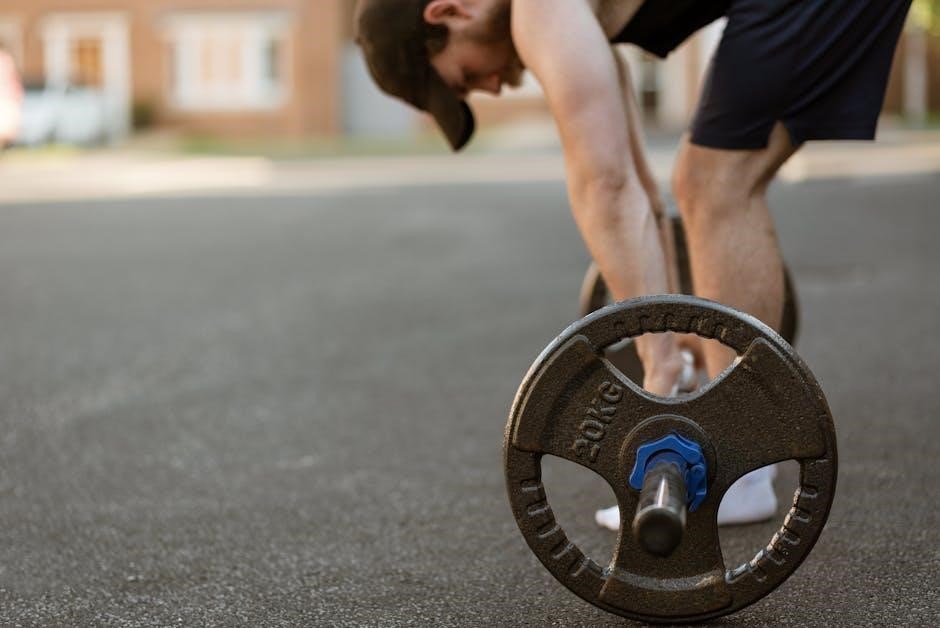
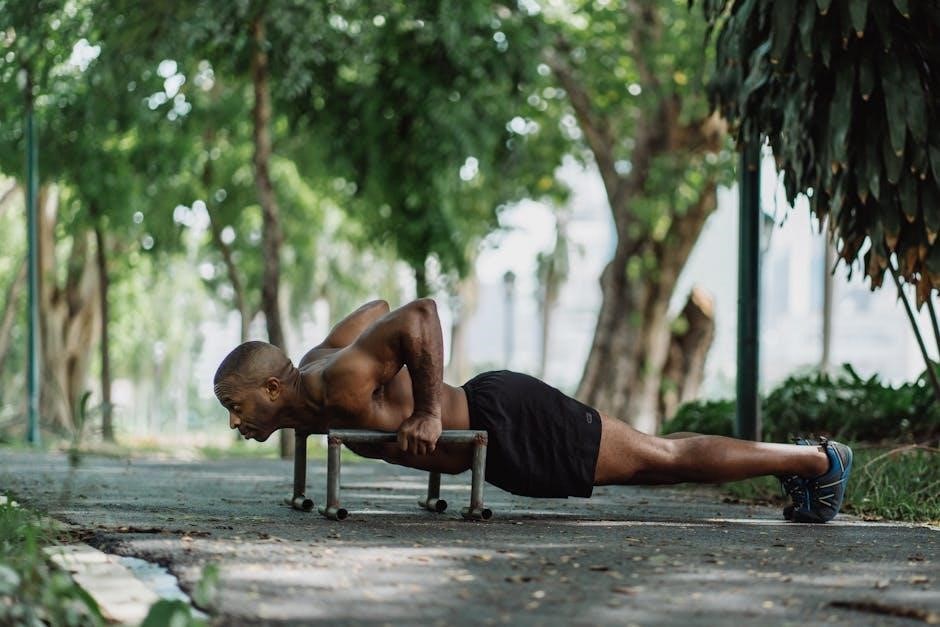
Benefits of Dip Bar Exercises
Dip bar exercises offer a cost-effective, space-saving way to build upper body strength, targeting triceps, chest, and abs. They are ideal for all fitness levels, promoting muscle growth and convenience.
Muscle Groups Targeted
Dip bar exercises primarily target the triceps, chest, and shoulder muscles, while also engaging the biceps and core for stability. The standard dip focuses on the triceps and lower chest, making it a powerful exercise for building upper body strength. Incline and decline push-ups shift the emphasis to different parts of the chest, while inverted rows engage the back and biceps. Tricep extensions isolate the triceps, and knee raises target the abdominal muscles. Even assisted dips and support holds require core engagement, ensuring a full-body workout. This versatility makes dip bar exercises an efficient way to strengthen multiple muscle groups simultaneously, catering to both beginners and advanced fitness enthusiasts.
Convenience and Cost-Effectiveness
Dip bar exercises are incredibly convenient, requiring minimal equipment and space, making them ideal for home workouts or gym sessions. They are highly cost-effective, as dip bars are an affordable investment compared to bulky gym machines or expensive memberships. Portable and easy to store, dip bars allow you to train anywhere, whether at home, in a park, or while traveling. Their versatility enables a wide range of exercises without the need for additional equipment, making them a practical choice for anyone looking to save money while maintaining an effective fitness routine. This accessibility ensures that dip bar exercises are a smart investment for fitness enthusiasts of all levels.
Scalability for All Fitness Levels
Dip bar exercises are highly scalable, making them suitable for individuals at any fitness level. Beginners can start with simpler variations like assisted dips or support holds, while more advanced users can progress to weighted dips or single-arm exercises. The ability to modify resistance, whether through body weight or added load, ensures that workouts remain challenging yet achievable. This adaptability allows users to gradually increase difficulty as they build strength and confidence. Whether you’re a novice or an experienced athlete, dip bar exercises can be tailored to meet your fitness goals, ensuring continuous progress and engagement without plateauing.
Essential Dip Bar Exercises
Dip bars enable a variety of effective exercises, including dips, push-ups, inverted rows, and tricep extensions, targeting multiple muscle groups for a full upper body workout.
These exercises are foundational for building strength and can be modified to suit different fitness levels, making them versatile for both beginners and advanced users alike.
The Standard Dip
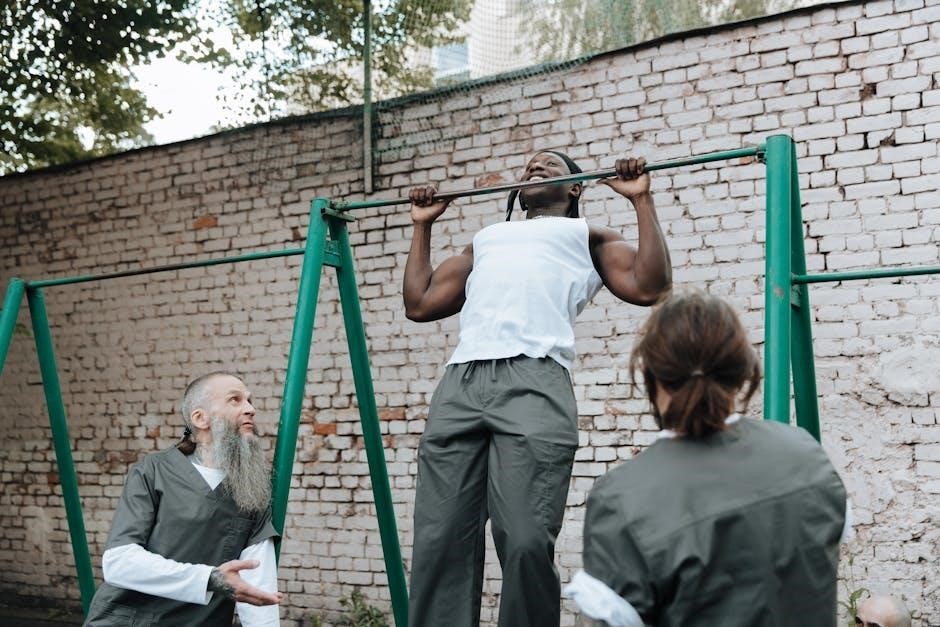
The standard dip is a fundamental exercise using dip bars, targeting the triceps and lower chest muscles. It involves placing your hands on the bars, extending your arms, and lowering your body until your elbows bend at a 90-degree angle. Push back up to the starting position, squeezing your triceps at the top. This exercise is bodyweight-based but can be made more challenging with added weight. Proper form is crucial to avoid shoulder strain and maximize muscle engagement. For beginners, negative dips or resistance bands can assist in building strength. The standard dip is a versatile and effective movement for building upper body strength and muscle definition.
Incline and Decline Push-Ups
Incline and decline push-ups are versatile exercises that utilize dip bars to target different muscle groups. For an incline push-up, place your hands on the bars, which are elevated, and lower your body while keeping your core tight. This variation reduces the weight you need to lift, making it easier and focusing on the lower chest muscles. Decline push-ups, where your feet are elevated, increase difficulty and emphasize the upper chest. Neutral grip push-ups on dip bars target the shoulders and triceps, while pike push-ups engage the shoulders and core. These variations allow you to modify the challenge and focus on specific muscles, making them ideal for all fitness levels.
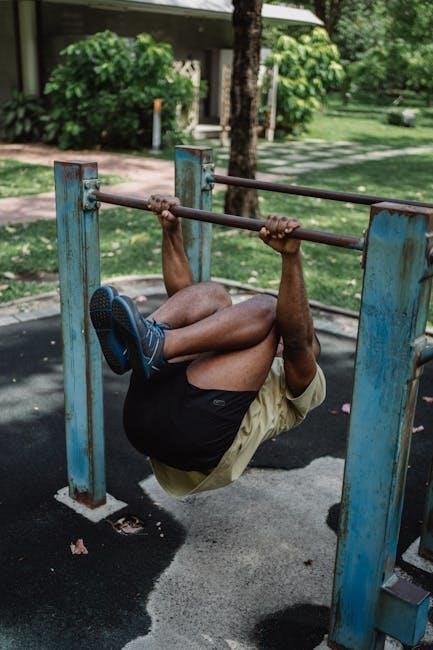
Inverted Row
The inverted row is a powerful exercise that targets the back, biceps, and trap muscles. To perform it, grip the dip bars with your hands slightly wider than shoulder-width apart and hang with your feet flat on the floor. Engage your core, pull your chest toward the bars, and squeeze your shoulder blades together at the top. Lower yourself slowly to the starting position, maintaining control throughout the movement. This exercise mimics the motion of a barbell row but uses your body weight instead. It’s an excellent option for building upper body strength and can be adapted to different fitness levels by adjusting the height of the bars or using resistance bands for added challenge.
Tricep Extensions
Tricep extensions are an effective way to isolate and strengthen the triceps using dip bars. This exercise is less challenging than dips, making it ideal for intermediate lifters. To perform a tricep extension, stand in front of the dip bars and grip them with your hands shoulder-width apart. Bend your knees slightly and lean forward at the hips, lowering your body until your elbows are bent at a 90-degree angle. Extend your arms fully, straightening your elbows to return to the starting position. If the bars are not adjustable, consider placing a soft surface under your knees for comfort. This exercise targets the triceps intensely and can be progressed by increasing repetitions or using weighted variations.
Knee Raises for Abs
Knee raises on dip bars are an excellent exercise for targeting the abdominal muscles, particularly the lower abs. To perform this exercise, hang from the dip bars with your hands shoulder-width apart and your legs straight. Engage your core and lift your knees towards your chest, keeping the movement controlled. Avoid swinging to ensure the focus remains on your abs. Lower your legs slowly back to the starting position. For added challenge, ankle weights can be worn, or the exercise can be modified to leg raises with straight legs. This exercise is ideal for strengthening the core and improving overall abdominal definition, making it a great addition to any workout routine focused on building a strong midsection.
Assisted Dips
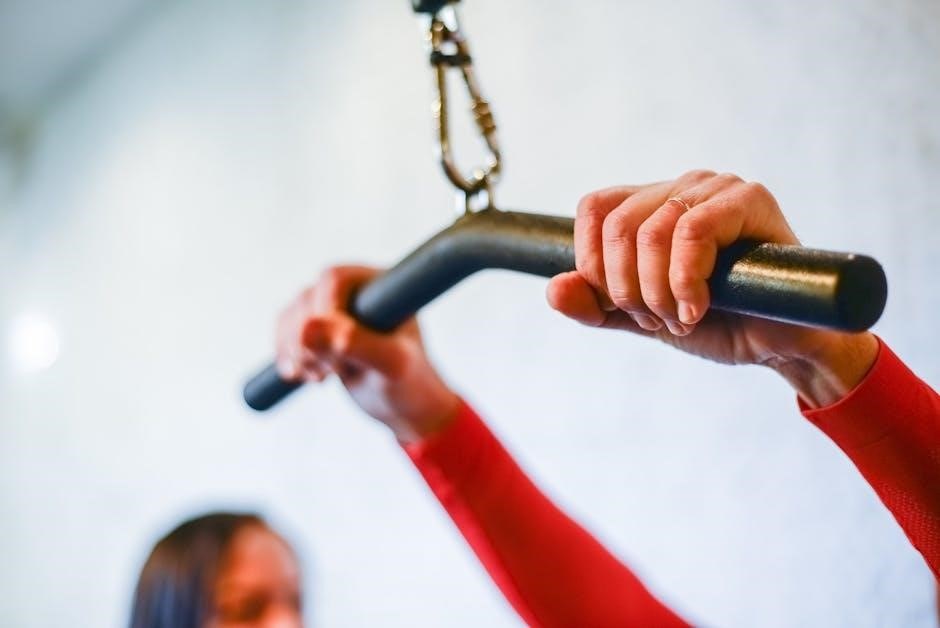
Assisted dips are a modified version of the standard dip, ideal for individuals who find regular dips too challenging. This exercise uses resistance bands or specialized machines to reduce the weight you lift, making it more accessible. To perform an assisted dip, attach a resistance band to the dip bars and place your feet or knees on the band. Lower your body slowly, then push back up to the starting position. This variation helps build strength progressively, allowing you to work towards unassisted dips over time. Assisted dips are a great way to improve tricep and chest development while minimizing strain on the muscles.
Pistol Squats
Pistol squats are an excellent dip bar exercise for targeting leg muscles, particularly the quadriceps, hamstrings, and glutes. This exercise is ideal for those who want to strengthen their lower body without heavy equipment. To perform a pistol squat, stand in front of the dip bars and hold them for support. Slowly lower your body into a single-leg squat, keeping the other leg extended forward. Push through your heel to return to the starting position. Pistol squats improve balance, coordination, and overall leg strength. If you find them too challenging, start with assisted variations or progress from regular squats. This exercise is a great way to build functional strength for daily activities.
Bicep Curls
Bicep curls using dip bars are a unique way to target your bicep muscles while engaging your core for stability. Unlike traditional curls with dumbbells, dip bar curls require controlled movement to maintain proper form. To perform this exercise, grip the dip bars with an underhand grip and hang slightly off the ground. Bend your elbows to pull yourself up, keeping your upper arms still, and focus on squeezing your biceps at the top. Avoid swinging or using momentum, as this can reduce the effectiveness and increase injury risk. For added challenge, you can incorporate weighted dips or resistance bands. This exercise is a great alternative to traditional bicep curls and can be easily incorporated into any workout routine.
Negative Dips
Negative dips are a variation of the standard dip, focusing on the lowering phase to build strength and control. They are ideal for those who find full dips challenging. Start by standing on a step or platform above the dip bars, gripping them firmly; Lower your body slowly, taking 2-3 seconds to reach the bottom position, with your elbows fully extended. Hold this position briefly before pushing back up or stepping down. This exercise targets the triceps, chest, and shoulders while improving strength for full dips. Using resistance bands can assist in making negative dips easier. Over time, this exercise helps build the necessary strength to progress to full dips.
Support Hold

The support hold is a fundamental exercise for building upper body stability and endurance. It involves gripping the dip bars and supporting your body weight with your arms fully extended. Keep your core engaged and body straight, holding this position for as long as possible. This exercise strengthens the shoulders, triceps, and core muscles while improving overall stability. It is particularly beneficial for beginners to build confidence and strength before progressing to more advanced dip exercises. Incorporating variations, such as leg raises, can increase the challenge and target additional muscle groups. The support hold is an excellent starting point for anyone new to dip bar training, helping to establish a strong foundation for more complex movements.
Advanced Variations of Dip Bar Exercises
Advanced variations like weighted dips, plyometric dips, and single-arm dips challenge experienced users, enhancing strength and power while targeting specific muscle groups for a intense workout.
Weighted Dips
Weighted dips are an advanced exercise that adds resistance to the standard dip, intensifying the workout for triceps, chest, and shoulder muscles. To perform, attach weights to a dip belt or hold a dumbbell between the legs. This variation increases muscle engagement and accelerates strength gains. Proper form is crucial to avoid injury, so focus on controlled movements and full range of motion. Weighted dips are ideal for experienced individuals seeking to challenge themselves beyond bodyweight exercises. Start with manageable weights and gradually increase as strength improves. This exercise is highly effective for building muscular endurance and power, making it a staple in advanced training routines.
Plyometric Dips
Plyometric dips are an explosive variation that adds power and intensity to the standard dip exercise. By incorporating a dynamic movement, plyometric dips target the triceps, shoulders, and chest muscles while improving muscular power. To perform, explode upward from the bottom of the dip, driving through the hands to propel the body upward. This exercise is ideal for advanced individuals looking to enhance their strength and explosiveness. Proper form is essential to avoid injury, with an emphasis on controlled, powerful movements. Plyometric dips are a great addition to a high-intensity workout routine, helping to build speed, strength, and overall athletic performance. Start with lower reps to master the technique before increasing intensity.

Close-Grip and Wide-Grip Variations
Close-grip and wide-grip dips are two popular variations that modify the standard dip exercise to target different muscle groups. A close-grip dip involves placing your hands closer together, which emphasizes the triceps and reduces chest involvement. Conversely, a wide-grip dip places your hands farther apart, shifting the focus to the chest and shoulders while engaging the triceps to a lesser extent. Both variations require proper form to maximize effectiveness and prevent injury. Adjusting your grip width allows you to tailor the exercise to your fitness goals, whether you aim to build tricep strength or enhance chest development. Incorporate these variations into your routine to diversify your workout and target specific muscle groups effectively.
Single-Arm Dips
Single-arm dips are an advanced variation of dip exercises that require exceptional strength and control. By using only one arm, this exercise intensifies the challenge, targeting the triceps, chest, and shoulders more intensely. It also engages the core for stability. To perform a single-arm dip, grip the dip bar with one hand and extend the other arm for balance. Lower your body until your elbow is bent at a 90-degree angle, then push back up to the starting position. This exercise demands precise form and strength, making it ideal for experienced individuals seeking to progress beyond standard dips. Mastery of single-arm dips is a testament to upper body prowess and control.

Safety and Proper Form
Proper form is crucial for safe and effective dip bar exercises. Always maintain controlled movements, avoid rounding your shoulders, and ensure full range of motion to prevent injuries. A spotter can provide additional safety.
Importance of Proper Form
Proper form is essential for maximizing the effectiveness of dip bar exercises while minimizing injury risk. It ensures that the targeted muscles are engaged correctly, preventing strain on joints and surrounding tissues. Improper form can lead to poor muscle activation and potentially harmful stress on the body. Maintaining controlled movements and full range of motion is critical for optimal results. Additionally, keeping the core engaged and avoiding rounded shoulders helps maintain stability and alignment. Prioritizing proper form not only enhances the workout but also promotes long-term safety and progress in strength training. Always focus on technique to reap the full benefits of dip bar exercises.
Common Mistakes to Avoid
When performing dip bar exercises, several common mistakes can hinder progress and increase injury risk. One of the most frequent errors is using rounded shoulders, which can strain the shoulder joints. Another mistake is not fully extending the arms at the bottom of the movement, which reduces the exercise’s effectiveness. Letting the hips swing during exercises like inverted rows or knee raises can also lead to poor form and reduced muscle engagement. Additionally, rushing through repetitions without controlled movements can compromise proper form and target muscles. Neglecting to engage the core is another oversight, as it destabilizes the body during exercises. Avoiding these mistakes ensures safer, more efficient workouts.
Preventing Injuries
Preventing injuries during dip bar exercises requires attention to proper form and controlled movements. Always warm up before starting to prepare your muscles and joints. Using resistance bands can help reduce strain, especially for beginners or those focusing on form. Ensuring the dip bars are stable and sturdy is crucial to avoid structural issues. For teenagers, proper supervision is recommended to ensure safe execution. Avoid overloading weights too quickly, as this can lead to muscle strain. Maintaining a slow and controlled tempo during exercises, especially dips and rows, minimizes injury risk. Prioritizing form over repetitions ensures long-term safety and effectiveness in workouts.

Progression and Routine Building
Progression involves gradually increasing reps, sets, or resistance. Start with basics like assisted dips, then move to weighted variations. Incorporate resistance bands or external weights to enhance intensity. Build a balanced routine by combining dips, rows, and tricep extensions. Focus on controlled movements to ensure proper form and steady progress. Adjust exercises based on fitness goals, ensuring continuous challenge and growth.
Starting with Basics
Starting with basic dip bar exercises is essential for building a strong foundation. Begin with assisted dips or support holds to develop strength and confidence. These exercises help improve form and reduce injury risk. Focus on controlled movements, ensuring proper alignment and muscle engagement. For newcomers, mastering the standard dip is crucial. Start with sets of 3-5 reps, gradually increasing as strength improves. Incorporate variations like tricep extensions or inverted rows to target specific muscle groups. Consistency is key; aim to practice 2-3 times weekly. As you progress, introduce more challenging exercises to continue building strength and muscle. Always prioritize proper form to maximize results and prevent injuries.
Using Resistance Bands
Resistance bands are a valuable tool for modifying dip bar exercises to suit different fitness levels. For beginners, bands can reduce the intensity by offering assistance, making exercises like dips or inverted rows more manageable. Simply loop the band around the dip bars and secure it under your feet or knees to alleviate some of the weight. For advanced users, bands can increase resistance, adding an extra challenge to movements like tricep extensions or bicep curls. This versatility makes resistance bands an excellent addition to any dip bar routine, allowing users to progress gradually and safely. They are lightweight, portable, and cost-effective, making them ideal for both home and gym workouts.
Increasing Repetitions and Sets
As you progress in your dip bar exercises, increasing repetitions and sets is key to building strength and muscle. Start with manageable numbers and gradually add more reps or sets over time. For example, if you complete 3 sets of 10 dips, aim for 4 sets of 12 next week. This gradual progression ensures consistent improvement without risking injury. Track your workouts to monitor progress and adjust your routine accordingly. Increasing volume also helps target different muscle groups more effectively, allowing for a well-rounded upper body workout. Remember, consistency and patience are crucial for achieving long-term fitness goals with dip bar exercises.
Dip bar exercises are a powerful tool for building strength and muscle, offering unmatched versatility and convenience. They support all fitness levels, helping you achieve your goals effectively and efficiently.
Final Thoughts on Dip Bar Exercises
Dip bar exercises are an exceptional way to enhance upper body strength and muscle definition. Their versatility allows users of all fitness levels to benefit, from beginners to advanced trainees. Whether you’re working out at home or in the gym, dip bars provide a cost-effective and space-efficient solution. By incorporating exercises like dips, push-ups, and rows, you can target multiple muscle groups efficiently. The ability to modify movements and add resistance makes them adaptable to individual goals. Consistency is key to seeing results, so make dip bar exercises a regular part of your routine. For a comprehensive guide, refer to the dip bar exercises PDF, which offers detailed instructions and variations to maximize your workout potential.
Encouragement for Consistency
Consistency is the cornerstone of progress in dip bar exercises. Regular practice helps build strength, muscle endurance, and confidence. Even small, incremental improvements add up over time. Celebrate each milestone, whether it’s completing more reps or mastering a new variation. The versatility of dip bars ensures workouts remain engaging, preventing boredom and keeping you motivated. Stay committed, and you’ll see lasting results. For guidance, refer to the dip bar exercises PDF, which provides structured routines and tips to keep your journey on track. Remember, every dip, push-up, and row brings you closer to your fitness goals.